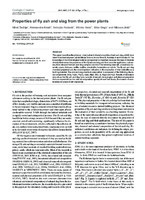Претрага
3 items
-
Properties of fly ash and slag from the power plants
This paper describes the physical, chemical and mineral properties of ash and slag, which were taken from thermal power plants Nikola Tesla A, Nikola Tesla B, Kostolac A and Kostolac B. The knowledge of the mineralogical material composition is important because the type of minerals directly determines the properties of the fly ash and slag and their possible application. Laboratory tests showed that ash and slag samples consist of the following minerals: amorphous materials, quartz, feldspar, mullite, melilite, cristobalite, ...fly ash, slag, physical composition, chemical composition, mineral composition, X-ray diffraction method... quired amounts of material were separated for the following tests: • physical examination of the ash and slag; • chemical analyzes of the ash and slag; • mineralogical tests of the ash and slag. The humidity samples, density of solid particles, grain size composition and pH value tests were done to ...
... the minimum and maximum values of ash and slag samples, are shown. For each power plant, six samples of fly ash in May were selected and one sample of slag. In June, three samples of fly ash were selected, with a total of 36 samples of fly ash and four slag samples (Table 1). The chemcial composition ...
... ash and slag, – using different types of coal from Kolubara and Kostolac basins, fairly good correlation coefficients for test samples of fly ash and slag were obtained, – from the analyzed dependencies and presented results of the correlation coefficients, it can be concluded that slag has much ...Miloš Šešlija, Aleksandra Rosić, Nebojša Radović, Milinko Vasić, Mitar Đogo, Milovan Jotić. "Properties of fly ash and slag from the power plants" in Geologia Croatica, Zagreb : Croatian Geological Survey (2016). https://doi.org/10.4154/gc.2016.26
-
Waste rocks and medieval slag as sources of environmental pollution in the area of the Pb-Zn Mine Rudnik (Serbia)
Alena Zdravković, Vladica Cvetković, Kristina Šarić, Aleksandar Pačevski, Aleksandra Rosić, Suzana Erić (2020)The new geochemical and mineralogical data of soil and water from the Pb-Zn Rudnik Mine area (central Serbia) reveal that the areas close to the mining sites and those located remotely from them are both affected by significant pollution by toxic elements, especially As, Pb, Ni and Cr. We, therefore, propose that two main sources are generally responsible for the current state of pollution in this area. The first is the material from waste rock dumps (WRDs) in which ...Alena Zdravković, Vladica Cvetković, Kristina Šarić, Aleksandar Pačevski, Aleksandra Rosić, Suzana Erić. "Waste rocks and medieval slag as sources of environmental pollution in the area of the Pb-Zn Mine Rudnik (Serbia)" in Journal of Geochemical Exploration, Elsevier BV (2020). https://doi.org/10.1016/j.gexplo.2020.106629
-
Application of Lignite Combustion Waste Slag Generated in Heating Plants as a Partial Replacement for Cement. Part II: Physical–Mechanical and Physical–Chemical Characterization of Mortar and Concrete
Milan Kragović, Nenad Ristić , Jelena Gulicovski, Andrijana Nedeljković, Snežana Pašalić, Ivica Ristović, Marija Stojmenović (2021)sagorevanje lignita, otpadna šljaka, zamena cementa, proizvodnja maltera i betona, fizičko-mehanička i fizičko-hemijska karakterizacija... The physical–mechanical testing showed that slag does not possess pozzolanic activity, and this was solved by mixing the slag with silica fumess in minimal amounts (slag/silica fumes = 88%/12%). The maximal possible cement replacement was 20% with 17.8% of slag and 2.2% of silica fumes. The leaching tests ...
... detailed physical–chemical and physical–mechanical characterizations of slag were performed [16]. In this paper, Nedeljković et al. [16] clearly showed the properties of waste slag and gave explanations and suggestions on how waste slag, which in raw form did not meet the prescribed conditions in terms of ...
... showed that the lack of slag in terms of the content of SiO2, Al2O3, Fe2O3, and unburned carbon, and the loss of ignition, may be overcome by the thermal treatment of the slag prior to use, up to 650 ◦C. Results also showed that other physical– chemical characteristics of slag (crystal, structural, and ...Milan Kragović, Nenad Ristić , Jelena Gulicovski, Andrijana Nedeljković, Snežana Pašalić, Ivica Ristović, Marija Stojmenović . "Application of Lignite Combustion Waste Slag Generated in Heating Plants as a Partial Replacement for Cement. Part II: Physical–Mechanical and Physical–Chemical Characterization of Mortar and Concrete" in Minerals, MDPI (2021). https://doi.org/10.3390/min11090925


